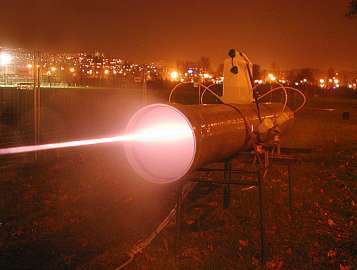![]()
Ultra-intense light filaments have successfully been sent through laboratory "fog" that approximates atmospheric conditions. This is an important step which should benefit several laser applications, such as free-space laser communication, monitoring of pollution, and range finding (see figure). Open-air laser light shows feature bright beams seemingly traveling interminably through the sky. But in general water droplets are an avid absorber of laser light. Now a group of physicists at the Universite Claude Bernard Lyon in France have used ultra intense (1014 watts/cm2), ultrashort (120 femtosecond) laser pulses to create "light filaments," streaks of light only 150 microns wide but hundreds of meters long, which can propagate through an artificial cloud of water droplets without losing much energy. The filaments form up through two competing nonlinear optical effects: the "Kerr effect" in which high intensity light modifies the index of refraction in the transmission medium (in this case air and water vapor) in such a way as to cause self-focusing; and the creation of a defocusing plasma effect. The French researchers now plan to test their scheme in the open atmosphere under controlled conditions. (Courvoisier et al., Applied Physics Letters, 14 July 2003; contact Jean-Pierre Wolf, 04072-43-13-01)

Ultraintense light filaments propagating through an open cloud chamber. (Courtesy, Universite Claude Bernard Lyon)